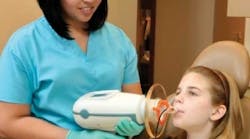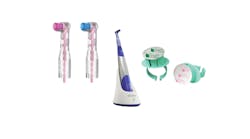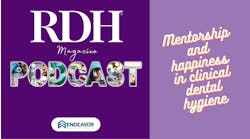Hand-held X-rays have become safer and easier to use
by Larry Emmott, DDS
Has this ever happened to you? You carefully place a film, ask the patient to bite, the patient winces and wiggles, you position the cone, reposition when it starts to drift, run from the room, push the button, wait for the beep, run back, take the film when the patient hands it to you, and the cone seems to have drifted again but you can't be sure. You gather your exposed films, trudge to the darkroom, put them in the machine, and find that in fact the X-ray film is cone cut, blurred, overlapped, the wrong tooth, or all of the above.Dental hygienists take most of the radiographs in a typical dental office, and experience the frustrations of taking X-rays on a daily basis. Fortunately there is an amazing new technology that eliminates many of the hassles and frustrations of taking radiographs in the traditional way. The Nomad from Aribex is a hand-held X-ray machine that allows you to stay in the room while you expose the image.
Most hygienists' first reaction to the idea of a hand-held X-ray device is, "Are you nuts? We've had X-ray safety protocol drilled into us since day one, and staying in the room and holding the thing is a huge no-no. We need to run from the room, preferably behind several walls and layers of lead, before we dare fire the tube head lest terrible horrors befall us."
That type of caution was certainly appropriate when Roentgen zapped the first molar in 1895, with what I believe was a 20-second exposure. However, today's amazing 21st century materials and equipment do in fact make it possible to stay in the room and hold the X-ray device.
The Nomad looks like a big ray gun from an old sci-fi film. There is a body, a pistol grip, and a cone or barrel that emits the X-rays. There are two features that make the Nomad safe. The body of the gun, which contains the X-ray generator, is fully enclosed in an exclusive blend of rare earth metals that completely block any radiation from escaping. So as long as you don't stand right in front of the barrel, the direct X-rays won't touch you.
Direct X-rays are only part of the issue. X-ray backscatter can be a real problem; that's why you were taught to run from the room. Nomad blocks the backscatter with an external backscatter shield. This is a clear ring of lead-infused acrylic that fits over the barrel and creates a cone-shaped protection zone. As long as the operator stands behind the device, he or she will be protected from backscatter.
That all sounds good in theory, but how does it work in the real world? Numerous studies have been done to ensure that the Nomad is indeed safe. In fact one study actually showed Nomad users received less exposure than those who used a traditional system. The independent experts assume that the Nomad design reduces stray radiation that might leak from an old-fashioned wall unit. The Nomad Web site (www.aribex.com) has links to the various studies if you want to see them.
The ability to stay in the room while you take the image and hold the tube eliminates most of the problems we encounter when taking X-rays. How about that overextended or out-of-adjustment arm that slowly slides south whenever you place it on the upper left? Or the arm that doesn't allow you to place the cone exactly parallel, so you have the patient slump down, twist the chair, and turn his or her head just so. No problem when you hold the cone.
Then there are the patients who just can't keep the film or sensor where you place it. As soon as you turn away they swallow or shift their bite, and your perfectly positioned sensor is no longer perfect. When you're standing next to them you can see if the sensor moves and fix it.
More importantly, if a patient wiggles or shifts the film, it is most likely because he or she is uncomfortable or anxious. When you place a sensor or film in the mouth of anxious patients who think they are about to gag and then you abandon them, there is no doubt their anxiety will increase. When you stay in the room, you can reassure patients with your words and presence.
Finally, there are elderly or special needs patients who have limited mobility or may be confined to a wheelchair. With Nomad, you do not need to drag them to the treatment room and maneuver them into the dental chair. You can take an X-ray image anywhere. In fact, as the ultimate benefit of mobility, you can use Nomad at a nursing home, mobile clinic, or humanitarian mission.
It is no longer 1895 or even 1995. With modern equipment, it is no longer necessary to run from the room when taking a radiograph. The future is coming and it is amazing!
Dr. Larry Emmott is the leading authority on dental high tech and one of the most entertaining speakers in dentistry. He is also a writer and consultant. To find out about his high-tech training programs, technology guides, and other services, call (602) 791-7071 or visit www.drlarryemmott.com.
Past RDH Issues







